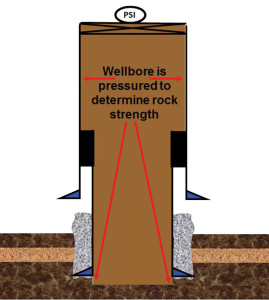Improving well control calls for continuous evaluation of barriers

Especially in deepwater, rig crews should maintain constant awareness of operational impacts on barriers
By John Shaughnessy, Signa Engineering
Traditional well control training teaches critical skills needed to recognize and prevent wellbore influx, such as recognizing pore pressure fluctuations at the bit, recognizing underbalanced conditions, how to shut in the well and how to properly handle a kick. However, well control events can also result from a failed barrier, so rig personnel should continuously evaluate the impact that operations can have on barriers specific to their project.
This article examines the importance of barriers used by the drilling industry to prevent well control events and to protect the environment. The intent is to increase awareness of barriers by examining the wellbore as a pressure vessel. Associated well control barriers include drilling fluid, casing, cement, casing shoes, wellhead seals, blowout preventers (BOPs) and the interaction among all of them.
Proper barrier-testing procedures, situations that can bring about changes in barriers and circumstances that might render barriers ineffective will also be discussed.
Traditional training is primarily focused on drilling operations. However, when drilling deepwater wells, the percentage of drilling time – rotating on bottom while drilling new hole – is sometimes less than 20%. It is important to understand that barriers can be impacted significantly during all well operations, not just drilling.

Background
When pulling a drill string from a well, deepwater rig crews routinely stop to assess the well control status. A similar assessment of wellbore barrier status would increase the team’s understanding of potential negative impacts on barriers. Table 1 shows an example check sheet, and Table 2 summarizes how some barriers can be negatively impacted by operations.
Drilling Fluid
The most common cause of blowouts in all types of drilled wells is not keeping the hole full of drilling fluid while pulling pipe from the well. The volume of steel pulled from the well must be replaced by drilling fluid, or the difference will eventually be replaced by reservoir fluid. It is critical for the rig team to monitor the hole fill on trips. If the hole is not filled, the bit can be several thousand feet off bottom when flow is recognized. Controlling an influx with the bit off bottom is significantly more difficult than with the pipe on bottom.


The drilling fluid barrier can also be reduced by lost circulation. Occasionally, a formation is drilled that cannot support the drilling fluid and force applied to the hole to circulate the fluid. This is a common problem in deepwater, but rarely does the fluid level fall significantly, even though circulation may be difficult.
In deepwater, the narrow margin between the pore pressure and fracture gradient requires multiple casing strings to be set (Figure 1). Casing is usually set when the mud weight required in the wellbore is within 0.5 ppg of the formation strength (Figure 2) at the previous casing shoe, which is mandated by regulations.
When drilling, circulating the mud applies pressure to the wellbore from dynamic friction necessary to push the mud from the well. The resulting equivalent circulating density (ECD) (Figure 3) of the mud is greater than the static mud weight. When the static mud weight approaches the 0.5-ppg “margin” to the fracture strength, the applied ECD further minimizes that margin. ECD can be increased by many factors, including:
Rate of penetration (ROP) increasing the cuttings load in the annulus;
Increasing ROP results in drilled cuttings packing off in the annulus. Mud pump pressure is applied to the wellbore; and
Mud properties change, increasing the viscosity.
The combination of static mud weight, ECD and the usually narrow margins between required mud weight and fracture gradient – rock strength – can result in lost circulation of the drilling mud. The effectiveness of drilling fluid as a barrier is reduced when the fluid level in a well falls. If lost circulation results only in mud pumped into the formation, the barrier is still effective.
Lost circulation caused by ECD usually does not result in a dropping annular fluid level but can limit the effectiveness of mud as a barrier. A falling annular fluid level has been observed when returns were lost due to a formation being pressure-depleted, resulting in significantly reduced rock strength.
The drilling fluid barrier becomes less effective if mud weight is unintentionally reduced. Potential of this error is low, but it can occur when high drill rates require the rig team to build mud volume at a high rate to keep up with the new hole.

The drilling fluid barrier is monitored and evaluated as follows:
Fluid flow rate in and out of the well is continuously monitored by sensors in the mud return line;
Volume in the pits is continuously measured by sensors and monitored by multiple team members;
Fluid weight in mud pits is checked frequently while drilling by rig personnel; and
Pressure while drilling (PWD) tools report ECD and equivalent static density (ESD) to confirm the actual drilling fluid barrier in the well.
Casing and Cement
These barriers work together. The objective of the casing and cement is to isolate shallower, lower-pressured formations from the formations to be drilled in deeper hole sections. Ideally, cement provides a barrier between formations behind a casing string to prevent cross flow (Figure 4).
Cement barriers can be ineffective due to mud contamination of the cement while circulating in place, which results from poor mud removal when cement is circulated into the annulus. Reasons for poor mud removal include:
Lost circulation due to narrow margins between mud weight, fracture gradient in the hole and the resulting ECD of the cementing operation;
Low circulation rate of the cement into the annulus. Higher circulation rate can lead to better mud removal but can contribute to higher ECD and potentially to an increase in lost circulation; and

Poor casing centralization because too few centralizers were run (Figure 5). Centralizers can increase risk to the cement-circulating operation. More centralizers expose sealing surfaces in the subsea wellhead to potential damage while running casing, increase surge pressures while running casing and can increase drag (resistance) on the casing string while running.
The cement barrier is evaluated after drilling the cement from the casing shoe and testing the formation. A poor or ineffective cement barrier will not isolate new hole from the formations covered by the recently run casing. Evaluation of the cement in the annular section of a casing string requires wireline logging surveys. The logs can evaluate cement placement to determine if the cement top is at the required depth and evaluate the uniformity of the cement around the casing.
However, cement evaluation logs have been shown to change over time. Logs run weeks after cementing can give a better indication of quality cement than logs run immediately after cementing.
The planned cement blend is lab tested to determine additive concentration to give the appropriate cement properties, thickening time and compressive strengths. Displacement hydraulics are simulated by most major cement vendors. During the mixing, the cement weight is constantly checked, most often by hand but also by sensors. The displacement parameters are recorded for checking against forecasted pressures.
The casing barrier is pressure-tested after cementing. Wear (wall thickness reduction) can reduce the effectiveness of the casing barrier. Wear can be caused by pipe rotation and can be directly related to the sideforce of the drill pipe against the casing, which can be directly related to the angle of the well and the dogleg, rate of angle change. Casing wear can be evaluated by wireline tools.
Wear can be minimized with smooth hard-banded drill pipe and non-rotating drill pipe protectors. Pipe rotation can be reduced by drilling with mud motors. The hydraulic power available from fifth-generation rigs would make minimizing rotation and drilling with motors an acceptable option.
Shallow-water flow from the well being drilled or an offset well can result in subsidence of the top hole. That subsidence can result in casing buckling. Wear and failure of buckled pipe due to the rotating drill pipe wearing a hole in it could become a major well control problem. The pipe failure would be within a few thousand feet of the seafloor. A hole there, below the BOP, would result in major lost returns and lost hydrostatic pressure against the reservoirs.
Casing is no longer an effective barrier if the bit from another well drills into the casing. This problem can result in loss of returns in the drilling well and require significant mud weight to kill a producing reservoir if the penetration occurs significantly above the reservoir. Normally this is only a problem where there is a platform or production well center. Anti-collision software is used by directional drillers to avoid occurrence.

Subsea wellhead seal
After cementing a full string of casing, the seal assembly is most often driven into the space between the casing hanger and the subsea wellhead (Figure 6). That assembly is positively tested immediately after setting.
Effectiveness of the seal barrier can be compromised if the seal does not lock into place. However, that failure is known when the running tool is pulled. A second seal assembly can be run to replace the failed seal after cleaning the sealing area.
The seal is negatively tested to ensure there is no pressure below the seal that could unseat the seal when hydrostatic pressure above the seal is reduced. The negative test is usually done prior to removing the BOP or reducing drilling fluid hydrostatic pressure.
Casing shoes
The check valve in the casing shoe (Figure 7) has two purposes: 1) keep heavier cement pumped into the annulus from U-tubing back into the casing after the cement is displaced, and 2) prevent flow from the wellbore from entering the casing while running it. Ideally, cement weight is at least 1 lb/gal heavier than the drilling mud. This can cause a problem when cement is pumped into the annulus without an effective float valve because the cement will flow back into the casing when the pumps are shut down. Check valves ensure the cement is in place, thereby minimizing cement movement and potential contamination.
Check valves also prevent flow into the casing while running casing. If the wellbore were to flow, the flow would go into the annulus, where it can be controlled by closing the BOP.
Without the check valve, the rig crew would be required to stab a casing swedge onto the casing, torque up the swedge and close a ball valve made up to the top of that swedge.
Often in deepwater wells, multiple casing strings are run with minimal clearance between the inner diameter of the pipe already cemented in the hole and the outer diameter of the pipe being run. Many operators use autofill casing valves that are open while running. The open shoe allows mud to enter the casing, which reduces the surge applied to the hole by the casing that is being run. The reduced surge pressure improves the chance that cement can be successfully circulated into the casing annulus. However, the autofill shoe requires the rig crew to be more diligent in monitoring for flow from the well because closing the BOP may potentially stop the flow. If the autofill shoe cannot be converted to become a check valve after running, the rig crew must hold pressure on the cement once it is displaced into the annulus.
Identifying a converted autofill shoe after cementing can be difficult if cement was not circulated high enough to create a U-tube pressure due to either:
Narrow margins between ECD and fracture strength that will not support a long cement column;
Returns that are lost due to high ECD from poor mud displacement;
Mud weight and cement weight that are not significantly different; or
Short column of cement.
Casing shoes cannot be pressure tested because their design allows pumping through the valve. After cement is displaced, the casing wiper plug can form a pressure barrier above the float valve. Thus, a positive test can be misleading.
The casing shoes can be negatively tested by reducing hydrostatic pressure inside the casing. If the shoes – and cement in the shoe track – have not become an effective seal, the formation or annulus hydrostatic can flow into the casing when the hydrostatic is reduced. Casing shoes are often negatively tested if the mud weight will be reduced to remove the BOP or if mud weight will be reduced to lower-weight completion fluids.
BOP
The BOP can be a barrier only when it is closed. Potential reasons the BOP might not be closed include:
Flow is not recognized due to rig activities, such as mud transfers, rig motion and pit sensor failures;
There is confusion regarding authority and responsibility to close the BOP;
There is a failure of BOP control systems; and
Closed BOP pipe rams do not seal due to improper space-out of a drill pipe tool joint.
To recognize kicks, most rigs closely monitor the flow rate from the wellbore and the volume of drilling fluid in the rig’s mud pits. An increase in either rate or pit volume is investigated. Operations on the rig can complicate recognition of flow from the well. Deepwater rigs often circulate at rates of 1,000 gal/min, thereby moving 1,400 bbls of mud/hr. Rigs can drill at rates of 150 ft/hr. In eight hours that would increase hole volume by more than 350 bbls. That high volume of fluid movement could mask flow from the well. Also, the crew must be focused on potential flow from the well. That focus can be distracted following pressure tests if those tests indicated that the wellbore is sealed, and therefore, no flow is possible.
The BOP may not be closed if well flow is not recognized. Rig motion and crane activities can occasionally cause mud pit sensors to give false indications of well flow. In such incidents, the rig team may not respond to an actual flow as quickly as needed. A ballooning or breathing formation squeezes drill fluid that had previously been lost to a fractured formation into the well. The ballooning usually occurs when the pressure in the wellbore is reduced, such as when ECD is eliminated (i.e., pumps are shut down) to make a connection.
During ballooning, the wellbore gains fluid similar to a well kick. If the rig team has not been fingerprinting the connections, measuring the gain when the pumps are shut down, a well flow compared with a ballooning formation will be more difficult to identify. Fingerprinting may also be called connection flow monitoring. Ballooning tendencies should be reviewed with the rig team. Those indicators are:
Drilling fluid has been lost to the formation;
Flow from the wellbore is decreasing, and a formation fluid flow will increase; and
Offset wells experienced ballooning.
Stuck pipe is a costly problem in many drilling operations. When the drill string is stationary, i.e., when circulating out a kick, the potential increases for the drill string to become stuck. To avoid pipe sticking, the rig team may hesitate in closing the BOP when conditions do not obviously indicate the well is flowing. The shut-in delay can result in a larger gain from a kick. Kick control is more difficult as the size of the influx increases. The rig team should have clear guidance to close the BOP when any flow is suspected.
Dynamically positioned rigs use electro-hydraulic multiplex (MUX) BOP control systems. To function the BOP, a signal is sent electronically to one of two control pods on the BOP to release hydraulic pressure stored on the BOP. The speed of the MUX system is required due to the potential of a dynamically positioned system upset. The systems are complicated but have built-in redundancy and have been shown to be very reliable.
The BOPs are pressure-tested every 14 days in most operating areas and function-tested seven days between the pressure tests. Most BOPs also are equipped with a system to automatically shut-in the BOP in the event the hydraulic and electronic links from the rig to the BOP are lost. The failure system is designed to protect the environment in the event of a control system failure.
Most subsea BOPs also can also be functioned by hydraulic power supplied by a remote-operated vehicle.
Barrier Rig Discussion
The following questions could raise awareness regarding rig operations and potential impact on well control barriers:
Is the fluid level or fluid weight going to be changed?
Is lost circulation a possibility? Will a depleted sand be drilled? Will returns potentially be lost while running casing?
Should casing wear be a concern based on rotating hours or casing angle?
Will cement be pumped to isolate the required formations?
What are the consequences of not circulating cement to the required depth?
Will a seal be set in a subsea wellhead or at a liner top?
Will a casing shoe be tested? Will casing be pressure-tested? Could failure impact the drilling fluid level?
Summary
Consideration of barriers would increase the drilling team’s awareness of potential failures that could lead to well control problems. The probability of a well control problem may be low, but the consequences are high enough to justify considering all causes.
References:
Skalle, Pal, et al, SPE 39354, “Trends Extracted from 800 Gulf Coast Blowouts During 1960-1996,” Dallas, March 1988.
Furlow, William, “How One of the Biggest Fields in the US Gulf Almost Got Away,” Offshore, May 1999.
Liu Gefei, “Predicting Surge Pressures That Result from Running Liners,” World Oil, April 2001.
Taib, Anuar, et al, “Auto-Fill Tool Cuts Formation Surge Pressures and Stops Expensive Mud Losses,” Drilling Contractor, January/February 2000.
Jeff Sattler, West Engineering Services, IADC/SPE 128941, “Just How Reliable is Your BOP Today? Results from a JIP, US GOM 2004-2006,” New Orleans, February 2010.




